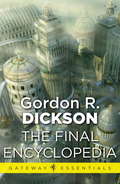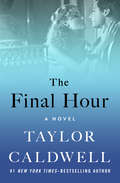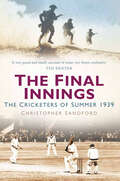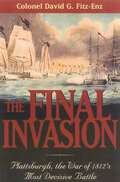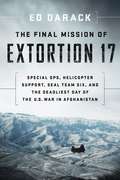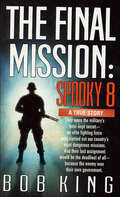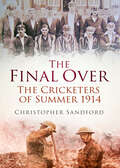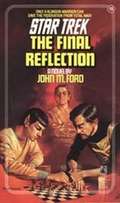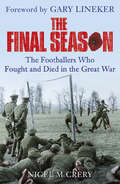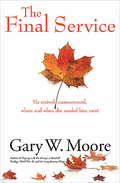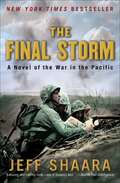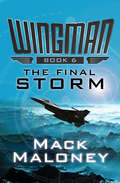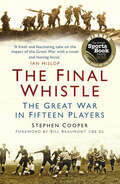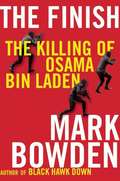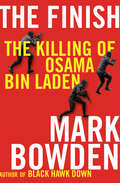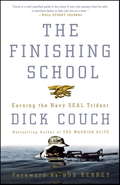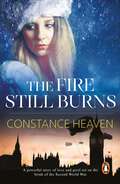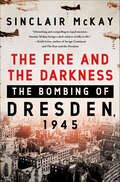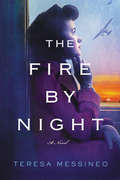- Table View
- List View
The Final Day (John Matherson Series #3)
by William R. ForstchenA major release in the New York Times bestselling One Second After series, set in an alternate America rebuilding after an electromagnetic pulse, this is William R. Forstchen's The Final Day. Since the detonation of nuclear weapons above the United States more than two years ago, the small town of Black Mountain, North Carolina has suffered famine, civil war, and countless deaths. Now, after defeating a new, tyrannical federal government, John Matherson and his community intend to restore their world to what it was before the EMP apocalypse. For the most part, they are succeeding. This period of relative stability doesn’t last long. A new, aggressive government announces that it’s taking over and ceding large portions of the country to China and Mexico. The Constitution is no longer in effect, and what’s left of the U. S. Army has been deployed to suppress rebellion in the remaining states. John fears he and his town will be targets. General Bob Scales, John’s old commanding officer and closest friend from prewar days, is sent to bring John into line. Will John and his people accept the new, autocratic regime? Or will revolution rip the fledgling nation apart at the seams? Months before publication, William R. Forstchen’s novel One Second After was cited on the floor of Congress as a book all Americans should read. This third book in the series immerses readers once more in the story of our nation’s struggle to rebuild itself after an electromagnetic pulse wipes out all electricity and plunges the country into darkness, starvation, and death.
The Final Encyclopedia: The Childe Cycle Book 7 (CHILDE CYCLE)
by Gordon R DicksonThe Final Encyclopedia tells of the events which occur when the human race is split into three splinter cultures: the Friendlies, fanatic in their faith; the truth-seeking Exotics; and the warrior Dorsai. But now humanity is threatened by the power-hungry Others, whose triumph would end all human progress. Hal Mayne is an orphan who was raised by three tutors: an Exotic, a Friendly and a Dorsai. He is the only human capable of uniting humanity against the Others. But only if he is willing to accept the terrible destiny of . . . Saviour of mankind.
The Final Fury: Invasion! #4
by Dafydd Ab HughFor ages they have sought to claim our worlds. Now, at last, we take the battle to them. . . . Far from the Federation's desperate war against the invading Furies, the crew of the U.S.S. VoyagerTM encounters something they never expected to hear again: a Starfleet distress call. The signal leads them to a vast assemblage of non-humanoid races engaged in a monumental project of incredible magnitude. Here is the source of the terrible invasion threatening the entire Alpha Quadrant -- and, for the Starship VoyagerTM, a possible route home. But soon there may not be any home to return to . . .
The Final Hour: A Novel (The Barbours and Bouchards Series #3)
by Taylor CaldwellIn the final chapter of the saga that began with Dynasty of Death and The Eagles Gather, a global munitions empire must take sides in World War II. Peter Bouchard journeyed from afar to intervene in the power struggle between Armand and Christopher Bouchard. At stake was control of the family’s vast conglomerate spanning the armament, airplane, and automobile industries. Now Peter and his wife, Celeste, have returned from Europe, where the winds of war are blowing once again. Peter warns that the coming conflict will be one of the darkest chapters in human history—but the Bouchards have always profited in dark times. Henri Bouchard has grown into a ruthless tycoon, but when he sees the threat to America, he throws himself into the war effort with single-minded determination. As he battles bureaucracy and rival powers within his own family, he finds himself drawn to Celeste, the woman he once loved. This, one of Taylor Caldwell’s most subtle romances, awakens Henri’s compassion even as it threatens his grip on the Bouchard dynasty. A “sprawling . . . lush” novel that captures the clamor and uncertainty of the years before the Second World War, The Final Hour is a fitting conclusion to the trilogy that stands as one of Caldwell’s finest achievements (Kirkus Reviews).
The Final Innings: The Cricketers of Summer 1939
by Christopher SandfordJoint winner of the Cricket Society and MCC Book of the Year 2020 awardThe declaration of war against Germany on 3 September 1939 brought an end to the second (and as yet, final) Golden Age of English cricket. Over 200 first-class English players signed up to fight in that first year; 52 never came back. In many ways, the summer of 1939 was the end of innocence. Using unpublished letters, diaries and memoirs, Christopher Sandford recreates that last summer, looking at men like George Macaulay, who took a wicket with his first ball in Test cricket but was struck down while serving with the RAF in 1940; Maurice Turnbull, the England allrounder who fell during the Normandy landings; and Hedley Verity, who still holds cricketing records, but who died in the invasion of Sicily. Few English cricket teams began their first post-war season without holding memorial ceremonies for the men they had lost: The Final Innings pays homage not only to these men, but to the lost innocence, heroism and human endurance of the age.
The Final Invasion: Plattsburgh, the War of 1812's Most Decisive Battle
by David Fitz-EnzA major event in both America's history and the European wars of the nineteenth century, the War of 1812's Battle of Plattsburgh saw the largest invasion ever of a foreign military into the United States, as the British army and navy, fresh from victories against Napoleon, attempted to conquer Lake Champlain and its shores. Their plan was to seize control of key waterways and port cities, a move that would cripple America's defenses. Outnumbered and outgunned, the U. S. land and sea forces fought the British ships and troops to a standstill, allowing the leader of the American fleet, Lieutenant Thomas Macdonough, to carry out a brilliant maneuver which ensured an American victory. Author Fitz-Enz researched and produced a companion PBS documentary that examined the leaders on both sides of the conflict and their actions during the battle. His research brought to light numerous documents, including diaries and secret battle orders, that reveal new insights into the battle. His descriptions of the confrontation in the pages of The Final Invasion bring to vivid life the cannon blasts that tore through ships and their crews and the rush of infantry storming the fortifications around the city. Endorsed by the U. S. Army War College, The Final Invasion is a thrilling look at a pivotal moment in American and world history.
The Final Mission of Extortion 17: Special Ops, Helicopter Support, Seal Team Six, And The Deadliest Day Of The U. S. War In Afghanistan
by Ed DarackOn August 6, 2011, a U.S. Army CH-47D Chinook helicopter approached a landing zone in Afghanistan 40 miles southwest of Kabul. The helicopter, call sign Extortion 17, was on a mission to reinforce American and coalition special operations troops. It would never return. Insurgents fired at the Chinook, severed one of its rear rotor blades, and brought it crashing to the ground. All 38 onboard perished instantly in the single greatest moment of sacrifice for Americans in the war in Afghanistan. Those killed were some of the U.S.'s most highly trained and battle-honed commandos, including 15 men from the Gold Squadron of the Naval Special Warfare Development Group, known popularly as SEAL Team 6, which had raided a Pakistan compound and killed Osama bin Laden just three months earlier. The downing of Extortion 17 spurred a number of conspiracy theories, such as the idea that the shootdown was revenge for bin Laden's death. In The Final Mission of Extortion 17, Ed Darack debunks this theory and others and uncovers the truth behind this mysterious tragedy. His account of the brave pilots, crew, and passengers of Extortion 17 and the events of that fateful day is interwoven into a rich, complex narrative that also discusses modern joint combat operations, the history of the Afghan war to that date, U.S. helicopter use in Afghanistan, and the new and evolving military technologies and tactics being developed to mitigate such tragedies now and in the future.Amazon Best History Book of the Month - September 2017
The Final Mission: Spooky 8
by Bob KingThe Final Mission tells the story of Bob King, who for seventeen years, beginning with his military career as a member of the Special Forces Unit in Vietnam, led an incredible double life, carrying out the U.S. government's high-risk missions--without involving its military. Then, in 1992, King and his men, secret members of a U.S. Tactical Reconnaissance Team, were sent to Colombia. The mission was "an easy breather," until the men walked into an ambush and found out the real reason they were there. They had been sent to die.With three men dead, and King himself wounded, the band of mercenaries began a desperate battle for survival-- and for the truth-- that led from South America all the way to Washington, D.C. Now, in this chilling, action-packed book, Bob King goes public: with the covert operations he carried out, the hidden deals he witnessed, and the horrific shadow war he survived-- against a U.S. government desperate to bury its secrets and its own men.
The Final Nexus: The Final Nexus (Star Trek: The Original Series #43)
by Gene DeWeeseUncounted centuries ago, an unknown race from beyond our galaxy created a series of interstellar gates -- shortcuts across our universe -- and then disappeared, leaving behind no clues to their fate, or the operation of their system. Twice before, the Enterprise has used the system to traverse the galaxy, and returned each time no wiser to the gates' operation. Now it is imperative that they find out. For the gates are breaking down, taking the very stars in the sky with them. The fate of the galaxy rests in the hands of the Enterprise crew, and their ability to communicate not only with creatures from another world -- but from another universe as well.
The Final Over: The Cricketers of Summer 1914
by Christopher SandfordAugust 1914 brought an end to the ‘Golden Age’ of English cricket. At least 210 professional cricketers (out of a total of 278 registered) signed up to fight, of whom thirty-four were killed. However, that period and those men were far more than merely statistics: here we follow in intimate detail not only the cricketers of that fateful last summer before the war, but also the simple pleasures and daily struggles of their family lives and the whole fabric of English social life as it existed on the eve of that cataclysm: the First World War. With unprecedented access to personal and war diaries, and other papers, Sandford expertly recounts the stories of such greats as Hon. Lionel Tennyson, as he moves virtually overnight from the round of Chelsea and Mayfair parties into the front line at the Marne; the violin-playing bowler Colin Blythe, who asked to be moved up to a front-line unit at Passchendaele, following the death in action of his brother, with tragic consequences; and the widely popular Hampshire amateur player Robert Jesson, whose sometimes comic, frequently horrific and always enthralling experiences of the ill-fated Gallipoli campaign are vividly brought to life. The Final Over is undoubtedly a gripping, moving and fully human account of this most poignant summer of the twentieth century, both on and off the field of play.
The Final Reflection: A Novel (Star Trek: The Original Series #16)
by John M. FordKlingon Captain Krenn is a ruthless war strategist. But on a mission to Earth, Krenn learns a lesson in peace. Suddenly he must fight a secret battle of his own. His empire has a covert plan to shatter the Federation. Only Krenn can prevent a war -- at the risk of his own life!
The Final Season: The Footballers Who Fought and Died in the Great War
by Nigel McCreryA moving narrative history of the professional footballers who fought and died in World War I, with a foreword by Gary Lineker.In 1914, as today, successful footballers were heroes and role models. They were the sporting superstars of their time; symbols of youth, health and vigour. Naturally enough, when war broke out they felt it was their duty to join up and fight. Between 1914 and 1918, 213 professional players fell in action. Some teams lost half their players, either killed or else so badly injured in mind and body that they were never to play again. The Final Season is the powerfully moving account of these young men who swapped the turf of the pitch and the cheers of the fans for the freezing mud of the battlefield and the terrible scream of shell fire. It follows them as they leave their fans and families behind, undergo training and then travel on to the bloody arenas of war: Ypres, Gallipoli, the Somme, Passchendaele. Nigel McCrery paints these men in vivid detail. From their achievements on the football pitch to their heroic conduct on the battlefield, we will learn of the selfless courage and determination they displayed in the face of adversity. For far too many, we will also learn when, and how, they made the ultimate sacrifice.
The Final Secret: The Final Secret / Colton First Responder (the Coltons Of Mustang Valley) (Mills And Boon Heroes Ser.)
by Cassie MilesA security agent must confront her own dark past to stop a deadly plot in the USA Today–bestselling author's romantic suspense novel.As her first assignment with ARC Security, army vet Gennie Fox is tasked with guarding a swanky fundraiser. It seems straightforward enough—until her traitorous ex-fiancé shows up. Suddenly a guest is murdered, and her boss—former SEAL Noah Sheridan—gets caught in the cross fire. Noah trusts the coolheaded beauty to get to the truth. But when Gennie’s past leaves her compromised, can their growing feelings survive the sinister forces at work?
The Final Service
by Gary W. MooreA father and daughter, a secret past, and a search for redemption drive this haunting novel that “celebrates the complexities of love” (Joyce Faulkner). Sandy Richards is a music teacher, wife, and mother living a comfortable life in a small Midwestern town. But her warm smile and easy laugh hide a heavy burden. During her childhood, she was inseparable from her larger-than-life father, a World War II hero she adored. Sandy followed him everywhere, hung on his every word, and loved him with all her heart. Until, for reasons Sandy never understood, their relationship shattered—left broken to the day he died. With grief, regret, and anger, Sandy sorts through her father’s belongings to learn what went wrong, and to deal with all the unresolved pain of the past. Then, as if by providence, a stranger enters Sandy life. And everything changes once more. Exploring the forces in nature that are more powerful than ourselves, The Final Service is “a compelling and endearing” novel about the need for forgiveness and to forgive, and to embrace what matters most in life while it’s still within reach (James Riordan, New York Times–bestselling author).
The Final Storm: A Novel of the War in the Pacific (World War II #4)
by Jeff ShaaraNEW YORK TIMES BESTSELLER With the war in Europe winding down in the spring of 1945, the United States turns its vast military resources toward a furious assault on the last great stepping-stone to Japan--the heavily fortified island of Okinawa. The three-month battle in the Pacific theater will feature some of the most vicious combat of the entire Second World War, as American troops confront an enemy that would rather be slaughtered than experience the shame of surrender. Meanwhile, stateside, a different kind of campaign is being waged in secret: the development of a weapon so powerful, not even the scientists who build it know just what they are about to unleash. Colonel Paul Tibbets, one of the finest bomber pilots in the U.S. Army Air Corps, is selected to lead the mission to drop the horrific new weapon on a Japanese city. As President Harry S Truman mulls his options and Japanese physician Okiro Hamishita cares for patients at a clinic near Hiroshima, citizens on the home front await the day of reckoning that everyone knows is coming.new weapon on a Japanese city. As the new president, Harry S Truman, mulls his options, and a Japanese physician named Okiro Hamishita cares for patients at a clinic near the city of Hiroshima, citizens on the home front await the day of reckoning that everyone knows is coming. A fitting conclusion to one of the most riveting sagas in military fiction, The Final Storm illuminates the heroism and sacrifice that defined the war in the Pacific, bringing the conflict to life as only Jeff Shaara can.From the Hardcover edition.
The Final Storm: The Final Storm (Wingman #6)
by Mack MaloneyOnly ace pilot Hawk Hunter can bring a Russian-backed traitor to justice. From &“the best high-action thriller writer out there today, bar none&” (Jon Land, USA Today–bestselling author). The Soviet Union had nearly been defeated when the vice president of the United States revealed himself as a traitor. He deactivated the defense grid just long enough for the Russians to strike, reducing America to a battle-scarred wasteland. The United States would have remained in shambles, were it not for Hawk Hunter, the greatest fighter pilot the world has ever known. He rebuilt the country one dogfight at a time, with one goal firmly fixed in his mind: to bring America&’s greatest traitor to justice. Backed by a team of commandos, Hunter storms the vice president&’s compound in Bermuda, and returns with the traitor in chains. To convict him for his crimes, the war&’s story must be told in full for the first time. And there is no one better to begin the telling than Hawk Hunter. He has risked his life on every front, and it&’s his courage that will ensure America rises again. The Final Storm is the sixth book of the Wingman series, which also includes Wingman and The Circle War.
The Final Whistle: The Great War in Fifteen Players
by Bill Beaumont Stephen CooperThis is the story of fifteen men killed in the Great War. All played rugby for one London club; none lived to hear the final whistle.Rugby brought them together; rugby led the rush to war. They came from Britain and the empire to fight in every theatre and service, among them a poet, playwright and perfumer. Some were decorated and died heroically; others fought and fell quietly. Together their stories paint a portrait in miniature of the entire war.Founded in 1879, when British soldiers fought in Afghanistan as they do today, Rosslyn Park has no war memorial. An old press cutting gave numbers – 350 served, 72 died – but no names. So began a quest to rediscover these men and capture their lives, from their vanished Edwardian youth and vigour, to the war they fought and how they died.
The Finish: The Killing of Osama Bin Laden
by Mark BowdenThe best-selling author of Black Hawk Down tells the story of the hunt for Osama bin Laden, based on extensive reporting, analysis, and interviews with President Obama, his national security staff, former SEALs, CIA officers, and others who can not be named.
The Finish: The Killing of Osama bin Laden
by Mark BowdenFrom Mark Bowden, the preeminent chronicler of our military and special forces, comes The Finish, a gripping account of the hunt for Osama bin Laden. With access to key sources, Bowden takes us inside the rooms where decisions were made and on the ground where the action unfolded.After masterminding the attacks of September 11, 2001, Osama bin Laden managed to vanish. Over the next ten years, as Bowden shows, America found that its war with al Qaeda-a scattered group of individuals who were almost impossible to track-demanded an innovative approach. Step by step, Bowden describes the development of a new tactical strategy to fight this war-the fusion of intel from various agencies and on-the-ground special ops. After thousands of special forces missions in Iraq and Afghanistan, the right weapon to go after bin Laden had finally evolved. By Spring 2011, intelligence pointed to a compound in Abbottabad; it was estimated that there was a 50/50 chance that Osama was there. Bowden shows how three strategies were mooted: a drone strike, a precision bombing, or an assault by Navy SEALs. In the end, the President had to make the final decision. It was time for the finish.
The Finishing School: Earning the Navy SEAL Trident
by Dick CouchIn America's new war, the first guns in the fight are special operations forces, including the Navy SEALs, specially trained warriors who operate with precision, swiftness, and lethal force. In the constantly shifting war on terror, SEAL units--small in number, flexible, stealthy, and efficient--are more vital than ever to America's security as they take the battle to an elusive enemy around the globe. But how are Navy SEALs made? What special training and preparation sharpen the physical skills and intangible character of a regular soldier into that of an elite warrior? In the acclaimedWarrior Elite, former Navy SEAL Dick Couch narrated one SEAL class's journey through BUD/S training, the brutal initial course that separates out candidates with the character and stamina necessary to begin training as Navy SEALs. InThe Finishing School, Couch follows SEALs into the next levels of training, where they further develop their endurance and strength, but also learn the teamwork and finely honed skills they'll need to fight with the best--and win. Dick Couch spent six months living with and observing SEALs in training for operational readiness in the months leading up to the Iraqi campaign. He follows them on the ground and in the water as they undergo SEAL Tactical Training, where they master combat skills such as precision shooting, demolitions, secure communications, parachuting, diving, and first aid. From there, the men enter operational platoons, where they subordinate their individual abilities to the mission of the group and train for special operations in specific geographical environments. Never before has a civilian writer been granted such close access to the training of America's most elite military forces. The Finishing Schoolis essential reading for anyone who wants to know what goes into the making of America's best warriors.
The Fire Still Burns: a powerful story of love and peril set in pre-war Europe and Russia
by Constance HeavenLet much-loved author Constance Heaven sweep you away in this captivating and compelling romance spanning pre-war Europe. Both heart-warming and heart-wrenching, this is perfect for fans of Fiona Valpy, Kristin Hannah and Katie Flynn.'Readable and atmospheric' -- DUBLIN TIMES.'Excellent! Difficult to put down' -- ***** Reader review'Exciting read' -- ***** Reader review'A great novel from a great writer' -- ***** Reader review***************************************************************Leading a demonstration for the starving children of the Rhondda, Luke Llewellyn Jones is literally swept off his feet by the daughter of a Russian princess. For it is Tanya who first hits, then carries him in her car to her father's hospital.It it something of an eye-opener for Luke to be invited to the Cambridgeshire home of Lord Aylsham, and to meet his delightful and unconventional family who chatter as easily in Russian as English. And all too easy to fall for the lovely and impetuous girl who still insists it was him that ran into her.But Luke's dream of winning Tanya's heart is broken the moment she meets the charming but enigmatic Dirk von Richter. She leaves England to live in a Europe trembling on the brink of war.And it is in very different and dangerous circumstances that Luke risks all to see her again - among the bleak and far-flung mountains of Siberia.
The Fire and the Darkness: The Bombing of Dresden, 1945
by Sinclair McKayA gripping work of narrative nonfiction recounting the history of the Dresden Bombing, one of the most devastating attacks of World War II.On February 13th, 1945 at 10:03 PM, British bombers began one of the most devastating attacks of WWII: the bombing of Dresden. The first contingent killed people and destroyed buildings, roads, and other structures. The second rained down fire, turning the streets into a blast furnace, the shelters into ovens, and whipping up a molten hurricane in which the citizens of Dresden were burned, baked, or suffocated to death. Early the next day, American bombers finished off what was left. Sinclair McKay’s The Fire and the Darkness is a pulse-pounding work of history that looks at the life of the city in the days before the attack, tracks each moment of the bombing, and considers the long period of reconstruction and recovery. The Fire and the Darkness is powered by McKay’s reconstruction of this unthinkable terror from the points of view of the ordinary civilians: Margot Hille, an apprentice brewery worker; Gisela Reichelt, a ten-year-old schoolgirl; boys conscripted into the Hitler Youth; choristers of the Kreuzkirche choir; artists, shop assistants, and classical musicians, as well as the Nazi officials stationed there. What happened that night in Dresden was calculated annihilation in a war that was almost over. Sinclair McKay’s brilliant work takes a complex, human, view of this terrible night and its aftermath in a gripping book that will be remembered long after the last page is turned.
The Fire by Night: A Novel
by Teresa MessineoTeresa Messineo’s The Fire by Night is a powerful World War II novel about two U.S. military nurses that illuminates women’s unsung heroism.An International BestsellerIn war-torn France, Jo McMahon, an Italian-Irish girl from Brooklyn’s tenements, tends to six seriously wounded soldiers in a makeshift medical unit. Enemy bombs have destroyed her hospital convoy, and now Jo singlehandedly struggles to keep her patients and herself alive in a cramped and freezing tent close to German troops. There is a growing tenderness between her and one of her patients, a Scottish officer, but Jo’s heart is seared by the pain of all she has lost and seen. Nearing her breaking point, she fights to hold on to joyful memories—the times she shared with her best friend, Kay, whom she met in nursing school.Half a world away in the Pacific, Kay is trapped in a squalid Japanese POW camp in Manila, one of thousands of Allied men, women, and children whose fates rest in the hands of a sadistic enemy. Far from the safety of her small childhood Pennsylvania coal town, Kay clings to memories of her happy days posted in Hawaii, and the handsome flyer who swept her off her feet in the weeks before Pearl Harbor. Surrounded by cruelty and death, Kay battles to maintain her sanity and save lives as best she can . . . and live to see her beloved friend Jo once more.When the conflict at last comes to an end, Jo and Kay discover that to achieve their own peace, they must find their place—and the hope of love—in a world that’s forever changed.
The Firefighter's Christmas Reunion: Same Time, Next Christmas The Firefighter's Christmas Reunion Fortune's Christmas Baby (Sugar Falls, Idaho #40)
by Christy JeffriesIn this interracial romance, a small town hopes a local firefighter’s reunion with a single mom of an adopted boy will result in a Christmas proposal.Home for the holidays with her adopted son from Ghana, Hannah Gregson runs straight into her former flame—fire chief Isaac Jones. Though the pair are determined to keep their distance, the local matchmakers throw them together at every holiday event, and Hannah’s son worships the brave ex-soldier. If Isaac isn’t careful, he just may go from hero to family man by Christmas!

